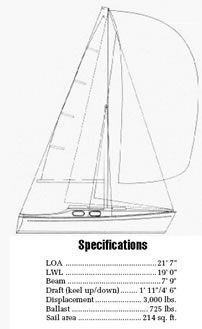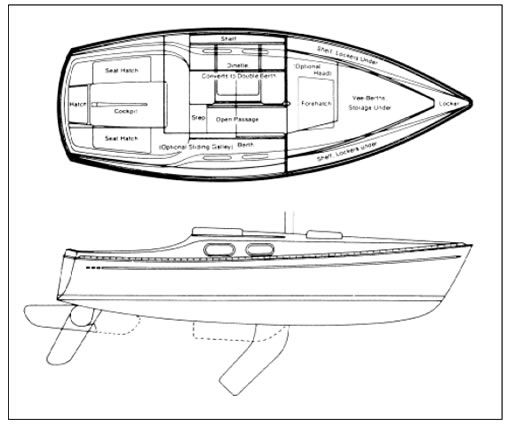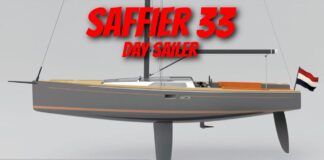
We’re still not sure if there’s a nationwide resurgence of interest in trailer sailers, but judging from the mail we receive, it certainly seems so. One of the used boats often mentioned is the Chrysler 22. It, like the 15′ Man O’War, 15′ Mutineer, 16′ 6″ Musketeer catamaran, 18′ Buccaneer and Chrysler 26 trailerable cruising sloop, were built by Chrysler Corporation’s Marine Products Group in Detroit, Michigan.
According to the BUC Research Used Boat Price Guide, Chrysler first offered recreational boats in 1957, building three aluminum runabouts and cruisers from 16′ to 21′. Its first fiberglass boat was the Caribbean 19′ cruiser in 1958. The Buccaneer was the first sailboat in the Chrysler line, introduced in 1971. The Chrysler 22 appeared in 1975. Just when Chrysler stopped building it is uncertain, but according to BUC, 1979 was the last year; we have not received information from readers owning boats built later than that, so perhaps ’79 was indeed the finale.
Two readers who responded to a 1995 appeal for information on Chrysler sailboat parts agreed that in the mid-80s Chrysler sold the molds and rights to the Starwind Division of Wellcraft Marine in Sarasota, Florida. Wellcraft is a large builder of powerboats. Starwind, according to one reader, “tooled up a more conventional deck mold and evidently sold some boats before it went under. That reader said a former Chrysler employee told him that the assets were purchased by a Brazilian-owned company in Florida which relocated back to Brazil. Another reader says that Wellcraft sold the molds and rights to Spindrift, which sold them to Rebel, which “was in the process of going out of business.” A third reader says it was produced for a time as the TMI 22 (Texas Marine International, which according to yet another source, bought the molds from Chrysler and in turn sold them to Wellcraft). No one seems to know where the molds are today.
The Design
The Chrysler 22 was designed by Halsey Herreshoff, now the city manager of Bristol, Rhode Island, the town where Nathaniel Herreshoff built so many great boats at the turn of the century. Halsey has designed a number of interesting boats, including the original hull for the Freedom 40.
The 22 was conceived as a trailer sailer with a swing keel that draws just 1′ 11″ up, though a fixed keel drawing 3′ 9″ also was available.
To maximize interior volume, the deck is more or less flush, though highly cambered. The deck fairs into the cockpit coaming, which leads cleanly into the backrests. There is a partial bridgedeck, unusual for a boat like this. The companionway widens at the coachroof to make cabin access more convenient. A pop top was optional, but these are always prone to leaking; a number of readers said they seldom use theirs.
Somewhat unusual is the inboard rudder, which pivots up for shallow water. There are numerous complaints about its sturdiness; and one reader said it is positioned too far forward.
The mast is mounted on a hinge and an early ad says there is a mast carrier to “make rigging simple.”
The boat displaces anywhere from 2,650 lbs. to 3,000 lbs. (depending on which brochure you believe), a bit heavier than most trailer sailers of this length. The Catalina 22, for example, displaces 1,850 lbs., the O’Day 22 and Venture 22 both 1,800 lbs. Ballast is 725 lbs., which is a lot of weight to carry in a swing keel.

Construction
The hull is of hand-laid fiberglass with a full inner liner. Foam flotation was standard. One owner said the core is Nomex; this is an aircraft honeycomb that achieved some notoriety for its use in the Stiletto 27 catamaran. Airex coring was reported by another owner. The owner of a 1977 model said the “deck has a brown water soluble glue throughout, that when it rains seeps into the cabin.”
While owners rate quality of construction as above average to excellent, a number of problems were cited in our questionnaires. These include leaks at the keel pivot pin, broken rudders (the original rudderstocks and cheeks were aluminum, the former being hollow; some have been replaced with stainless), weak spreaders, and poor quality turnbuckles.
One owner replaced the bulkheads, which seems like a rather extreme measure. “The factory bulkheads are probably strong enough,” he said, “but I replaced all of them with much heavier material.”
On the plus side, nearly all agree that the hull is heavily laid up, and that the spars are larger sections than one would expect on a boat of this size. Fittings were said to be of satisfactory quality. The trailer supplied by Chrysler is only adequate; a number of owners said it would be better to buy a heavier-duty trailer elsewhere. A double-axle trailer with brakes is recommended.
In the October 1, 1995 issue, we published under “Spare Parts” a source for some Chrysler parts, given to us by Hooper’s Yachts, 599 Manning Ave. S., Afton, MN 55001; 612/436-8795.
Bill Hooper said that his yard has worked on many Chrysler boats over the years, and has found some parts from Cardinal Yachts, Rte. 3, Box 1080, Gloucester, VA 23061.
Performance
Many owners report that light air performance is not exactly sparkling, attributing this to the boat’s relatively heavy displacement. The sail area/displacement ratio of 16.5 isn’t bad, however. In fact, owners spacious who bought larger genoas (up to 170%) report significant increases in sailing speeds.
In terms of stability, initial tenderness was a frequent comment, though ultimate stability was not a concern. The boat is claimed to be self-righting, even with the keel up. “Goes to about 22 degrees quickly, then stops. Cannot put rail under,” said one owner. The few owners of fixed keel models noted how much stiffer their boats are than the swing keel models.
To get the most out of the boat, owners suggest playing with the keel angle (which helps minimize weather helm) and installing the usual sail handling devices: larger boom vang, down haul, better quality traveler and so on. Several said that the keel was not faired particularly well, and that grinding it smooth and fair produces a noticeable improvement in performance.
The same was said about converting to mid-boom sheeting.
In summary, the boat performs best in moderate winds, and by using the various controls available, it will balance reasonably well and sail at average speeds.
Auxiliary power is furnished by an outboard mounted on the transom bracket. Models mentioned include Honda 5 and 10, Johnson 6 and 9.9, Seagull 5, Chrysler 6 and 10, and Evinrude 9.9., all long shafts. The separate, sealed tank compartment is much admired. Remote controls are regarded as a great convenience as well as a safety feature.

Interior
The basic plan provides for a V-berth forward, convertible dinette to port and a berth/settee to starboard, which may be occupied at times by the optional slide out galley. The $375 cost of the galley unit was considered overpriced by at least one respondent.
Some have made their own.
The partial bulkheads give a sense of spaciousness, which is important in a small boat with just sitting headroom. The centerboard trunk is not too tall, but does have an effect on moving around. A few owners said they thought that the cockpit suffered at the expense of the interior; the tiller extends to the bridgedeck, meaning that everybody in the cockpit will be in the way of the helmsman.
As mentioned earlier, there is a full inner liner or pan that predetermines the location and use of most spaces. Nevertheless, many owners report customizing the interior. Most often mentioned is the making of their own galley module. A few have raised the bridgedeck to the cockpit seat level. A few have upgraded the electrical panel.
The large V-berth is an attractive feature, and probably worth the absence of a private head (a portable toilet is located underneath). The sloping deck does diminish headroom forward, however.

Conclusion
The Chrysler 22 is still much admired for its clean lines and good looks. The option list, as with many small boats of its day, was long: pulpits and lifelines, galley and water tank, portable cooler, outboard bracket, toilet, curtains, backstay adjuster, running lights, mainsail cover, cushions, boom vang and more. Presumably, most used boats on the market today have these “accessories.”
We have always enjoyed customizing our boats, but do so with extreme caution, because when it comes time to sell (and every boat is sold sooner or later), it could be difficult finding a buyer who likes the reclino-lounge chair and navigation table you’ve installed in place of the dinette! We’d be wary of buying a boat with oddball “upgrades.”
The area of most concern with the Chrysler 22 is the rudder and rudderstock; if it still has the original hollow aluminum stock, we’d plan on replacing it. This probably will require some custom metalwork from a shop.
One should be able to buy a Chrysler 22 for somewhere between $4,000 and $5,000, depending on condition and equipment, the trailer and motor being the two most important pieces of extra gear. For an introduction to the joys of cruising, we think it’s one of the better mid-70s trailer sailers, though we’d also take a good look at a couple of other boats: the Tanzer 22 and O’Day 23.







































Cardinal Yachts, Harry Sindle was building the Mutineer and Buccaneer in Ware Neck Virginia in the early 90’s I also saw a few Rhodes 22’s and Hamptons.
Does the Chrysler 22 have a drain plug? I’m looking at one that’s been sitting for several years, water about 6” over the floor.
1. Get a siphon hose placed low in the boat and draw out the water into the low end of the cockpit. 2. Get a half gallon plastic water pitcher. Sit inside the cabin with your feet in the water and begin bailing into the cockpit. 3. Get a small 12 volt bilge pump or baitwell pump and drop it into the water.
Hi All, I bought a C-22 a few years ago, the water in the bottom was from the swing keel fittings leaking. I would recommend replacing the fittings and pin, don’t worry the fittings are made of pipe flange & fittings. Also to prevent keel klunk and the keel wearing thru the hull i used a nylon cutting board to fill the gap on each side of the swing pin. using 3M 4200 adhesive its worked fine. the adhesive needs to be used once its opened so have everything cut and fitted. I just got on this site today, our long winter at lake Superior has tested my patience……I’ve also started a u-tube channel with some random vidieos, I promise to have more instructional vidieos this year including the sail pack and new solar panel installation i made “Sailing Lake Superior George Kramer”